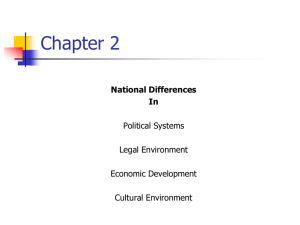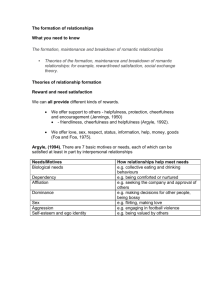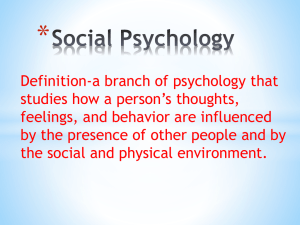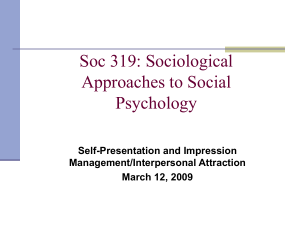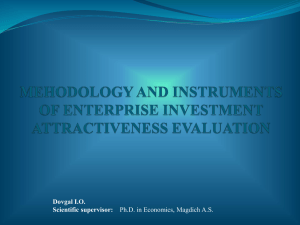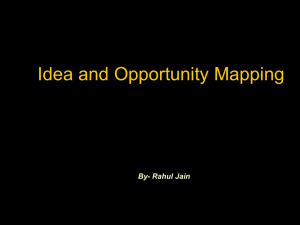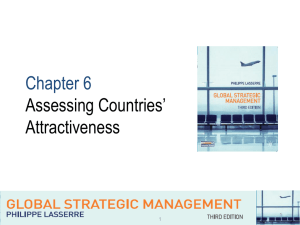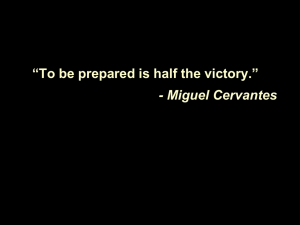STRESS AND ITS EFFECTS
advertisement
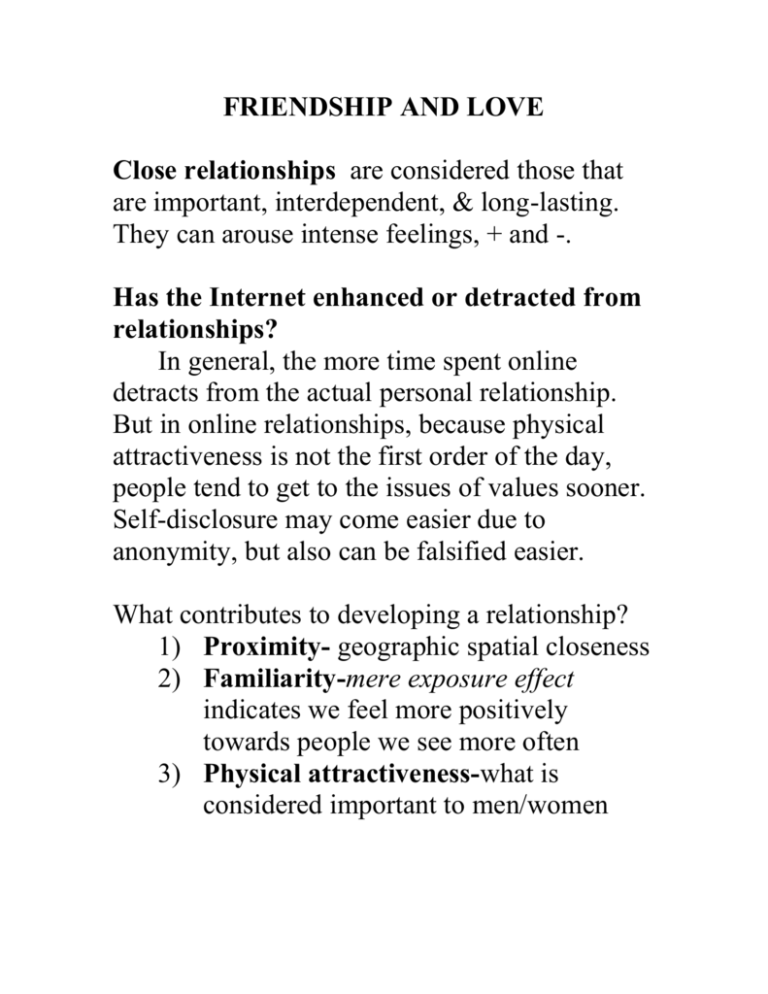
FRIENDSHIP AND LOVE Close relationships are considered those that are important, interdependent, & long-lasting. They can arouse intense feelings, + and -. Has the Internet enhanced or detracted from relationships? In general, the more time spent online detracts from the actual personal relationship. But in online relationships, because physical attractiveness is not the first order of the day, people tend to get to the issues of values sooner. Self-disclosure may come easier due to anonymity, but also can be falsified easier. What contributes to developing a relationship? 1) Proximity- geographic spatial closeness 2) Familiarity-mere exposure effect indicates we feel more positively towards people we see more often 3) Physical attractiveness-what is considered important to men/women Key elements of attractiveness: 1) Facial features In men: strong jaw/ broad forehead In women: baby-faced features with mature features like high cheekbones, narrow cheeks, wide smile 2) Physique IN men: broad shoulders, slim waists, small butt, tall In women: hourglass figure, medium breasts, thinness (but this is cultural, African American men prefer rounder women) Attractiveness seems to be more important for women in forming relationships than for men. Men emphasize material resources. The matching hypothesis states that people of similar levels of attractiveness gravitate toward each other. (It’s also suggested that the matching happens due to SES and other cultural forces, that we all try to pursue more attractive people.) Resource exchange- males trade occupational status for physical attractiveness in females. This is evident in descriptors used in classified ads. Parental investment theory- mating patterns depend on what each sex has to invest- time, energy, survival risk- to produce viable offspring. The ones who invest the least will compete the most for the opportunity to mate with the ones who make the most investment. The gender that has the larger investment will be more discriminating in selection of a partner. (women in our culture) This selectivity for most women includes finding a partner who brings material resources in to care for offspring. Factors in developing a relationship: 1) Reciprocal liking- we like those who show they like us.(Playing hard to get only works if there is already an established attractiveness) 2) Similarity- we like people who seem more like us in significant ways: demographics, attractiveness, intelligence, attitudes, personality, especially emotional needs. 3) Desirable personality characteristics- especially important when forming a long-term relationship. Relationship maintenance- all the activities used to sustain the quality of a relationship. Phoning, eating together, travel, interactions with friends/ family, emotional support. Minding is what it takes to keep a relationship alive and healthy- self-disclosure, positive attributions about the other, active listening, understanding the other’s attitudes, needs. Low minding is shown by lack of interest in partner’s activities or self-disclosures, negative attributions, focus on partner’s faults, pessimism about the future of the relationship. Social exchange theory- says that interpersonal relationships are governed by perceptions of rewards vs. costs of the relationship. We keep a ledger of what we’re getting and what we’re giving. We try to maximize our rewards in life and minimize their costs. Rewards- emotional support, status, sex Costs- time, energy, obligations, conflicts, trading off activities with others When the balance tips in a negative direction, we start thinking about termination. We compare relationship outcomes to our expectations. The comparison level is an acceptable balance or rewards/ costs. It may be influenced by past relationship experiences, other’s relationships, fantasy relationships. Satisfaction with a relationship is higher when rewards are high and costs are low. We also estimate comparison level for alternatives available. (Which is why people stay in unsatisfying marriage until a better alternative comes along.) Interpersonal marketplace. Investments are all the things we have given to the person/relationship that they can never back. Sometimes people hunker down and invest even more in an unsatisfying relationship, others get out when they see there’s no future. Friendship- what makes for a good friend? Loyalty is number one. Other aspects are warmth/ affection, supportiveness, honesty, humor and letting a friend be him/herself. Conditional acceptance is too much like parents treat children in a misguided effort to motivate them to change. Women’s friendships are more emotionally based (talk based on people, problems, feelings) Men’s are activity based (talk is about the activity, sports, work, not personal concerns). Women’s relationships are generally considered more intimate, but in other countries where men aren’t socialized to see other men as competitors, they share warmer rel. w/ men. Romantic love- we believe many myths in our fantasies about love: 1) When you fall in love, you’ll know it. 2) When love strikes, you have no control over it. (Love is a spell.) 3) True love lasts forever. (Reinforced by the fact that when people fall out of love, they reinterpret the relationship as never being love in the first place.) 4) Love can conquer all problems. (which leads people to overlook obvious problems and commit anyway). Sexual orientation-one’s preference for sexual or intimate relationships with individuals of the same, other or both genders. Dynamics of both types are similar. Gender differences in love: Who are the more romantic, men or women? Men! They hold more romantic beliefs, fall in love more easily than women, women fall out of love more easily than men. Women are more likely to say they would marry someone they didn’t love! Women suffer less emotionally when relationships break up than men do. Women do experience more physical symptoms of being “in love”, and they display more obvious tender emotions than men. Sternberg’s triangular theory of love: all love experiences are made up of 3 components: 1) Intimacy- warmth, closeness, sharing feelings, support. 2) Passion- intense feelings including sexual feelings 3) Commitment- decision to maintain a relationship in spite of the costs. Various combinations of these 3 result in 8 love types. With all 3 present, it’s consummate love. Another theory of love suggests that adult love is a reflection of infant attachment (revealed by fascination with the other, distress at separation, efforts to stay close.) Ainsworth defined basic attachment styles- typical ways of interacting in close relationships. The template for this is formed in infancy with the primary caregiver. 1) Secure-welcomes contact, feels safe. 2) Anxious-ambivalent- insecure and resistant of contact. 3) Avoidant- child avoids/ ignores other. These styles are promoted by the type of parenting offered. But in adult relationships: 1) Secure adults- 55%, trust others, easy to get close to, comfortable with interdependence. 2) Anxious adults- 20%, obsessive in relationships, need more closeness than partners, extreme jealousy, major fears of abandonment. 3) Avoidant- 25%, fear intimacy, uncomfortable in close relationships, resist trusting others, have the poorest success in relationships. Bartholomew described attachment based on our perceptions of ourselves (self-worth) and our perceptions of others’ trustworthiness. These styles particularly relate to conflict-management styles. Secure people have more successful resolution techniques. They also have greater job satisfaction, gender roles and religious beliefs. Attachment styles tend to be stable over time but are subject to change in the face of negative or healing, positive events/relationships. Why does the passion fade over time? Fantasy, novelty, and arousal all decline with time. Reality undermines idealizations. Satisfying relationships evolve as the passion fades. So why do relationships fail? 1) Premature commitment 2) Ineffective communication/ conflict management skills 3) Become bored with relationship 4) Availability of a more attractive relationship. How can you protect your relationship? 1) Take time to get to know the other person before making a commitment. 2) Emphasize the positive qualities in your partner (don’t attribute errors to personal failings) 3) Find ways to bring novelty to the relationship- especially doing physically challenging, exciting activities. 4) Learn effective conflict management styles- not everything is a big deal, when you fight, no kitchen-sinking. Negotiate differing needs, don’t dismiss them as unimportant. Loneliness is not synonymous with being alone. It is defined by having fewer interpersonal relationships than desired. The loneliest group is adolescents/ young adults. Singles are more lonely than marrieds, women more than men. It may be due to early experiences of rejection, often due to poor social skills. Cultural changes have isolated people more in recent days.

